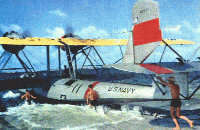Navy Patrol Bombing Squadrons 102/14 Association |
Navy Patrol Bombing Squadrons 102/14 Association |
CHRONICLE |
Patrol Squadron 14 |
Patrol Squadron 14Archive and Microfilm Research
|
 VP-14 P2Y "Click" for full picture |
![]() The United States Navy, for reasons unknown, redesignated the squadron
from VP-21 to VP-45 in August of 1939. In November of 1939 the
designation was changed again. This time to VP-14. It was the birth
of VP-14. From 15 April 1941 to 1 July 1941 the squadron designation
was again changed. This time to VP-26. The designation was changed
back to VP-14 on 1 July 1941. VP-14 was located at
Kaneohe Bay, T.H.
when the Japanese sneak attack occurred on 7 December 1941. Three of
VP-14's aircraft were airborne on patrol when that disasterous attack
occurred on Pearl Harbor, NAS Kaneohe, Schoffield Barracks, Hickam
Army Air Corps Base and other military installations.
The United States Navy, for reasons unknown, redesignated the squadron
from VP-21 to VP-45 in August of 1939. In November of 1939 the
designation was changed again. This time to VP-14. It was the birth
of VP-14. From 15 April 1941 to 1 July 1941 the squadron designation
was again changed. This time to VP-26. The designation was changed
back to VP-14 on 1 July 1941. VP-14 was located at
Kaneohe Bay, T.H.
when the Japanese sneak attack occurred on 7 December 1941. Three of
VP-14's aircraft were airborne on patrol when that disasterous attack
occurred on Pearl Harbor, NAS Kaneohe, Schoffield Barracks, Hickam
Army Air Corps Base and other military installations.
 VP-14 PBY's "Click" for full picture |
![]() Patrol Squadron 14 , operating under the authority of Patrol Wing One, served in many locations throughout the Pacific Theater during the early years of WWII. Segments of the squadron were often sent to various locations in order to satisfy the needs of the Pacific Fleet. Locations and battles that are common knowledge among the members of VP-14 have long since been forgotten by the generations who have followed. Long forgotten are such names as Canton Island, Suva, Wallis Island, Levuka, Noumea, Efate, Nadi, Johnson Island and Palmyra. Only the memories remain.
Patrol Squadron 14 , operating under the authority of Patrol Wing One, served in many locations throughout the Pacific Theater during the early years of WWII. Segments of the squadron were often sent to various locations in order to satisfy the needs of the Pacific Fleet. Locations and battles that are common knowledge among the members of VP-14 have long since been forgotten by the generations who have followed. Long forgotten are such names as Canton Island, Suva, Wallis Island, Levuka, Noumea, Efate, Nadi, Johnson Island and Palmyra. Only the memories remain.
![]() On 15 February 1943 the PBY, now obsolete, was replaced with the PB4Y-1 Liberator, a faster and more heavily armed aircraft. Most of the members of VP-14, along with appropriate equipment was transferred to form the nucleus of Bombing Squadron 102 (VB-102). The squadron had distinguished itself thoughout a wide area of the pacific during the early years of WWII. All members can well stand
proud for the accomplishments and deeds performed during the era of Patrol Squadron 14. In the Navy's terminology, "WELL DONE".
On 15 February 1943 the PBY, now obsolete, was replaced with the PB4Y-1 Liberator, a faster and more heavily armed aircraft. Most of the members of VP-14, along with appropriate equipment was transferred to form the nucleus of Bombing Squadron 102 (VB-102). The squadron had distinguished itself thoughout a wide area of the pacific during the early years of WWII. All members can well stand
proud for the accomplishments and deeds performed during the era of Patrol Squadron 14. In the Navy's terminology, "WELL DONE".
| VP-14 Casualties | VP-14 Deployment Diary | VP-14 Action Reports |
| VP-14 Lineage Summary | VP-14 Pearl Harbor | VP-14 Medal of Honor |
| 07 December 1941 | VP-14 Killed In Action |
VP-14 Killed In The Line Of Duty |
| VB-102 | VB-102 | VB-102 Action Reports |
| VB-102 | VB-102 | VB-102 Medal of Honor |
| VB-102 | VB-102 Killed In Action |
VB-102 Killed In The Line Of Duty |
Patrol Bombing Squadron 102
|
| VPB-102 | VPB-102 | VPB-102 Action Reports |
| VPB-102 Lineage Summary | VPB-102 | VPB-102 |
| VPB-102 | VPB-102 Killed In Action |
VPB-102 Killed In The Line Of Duty |